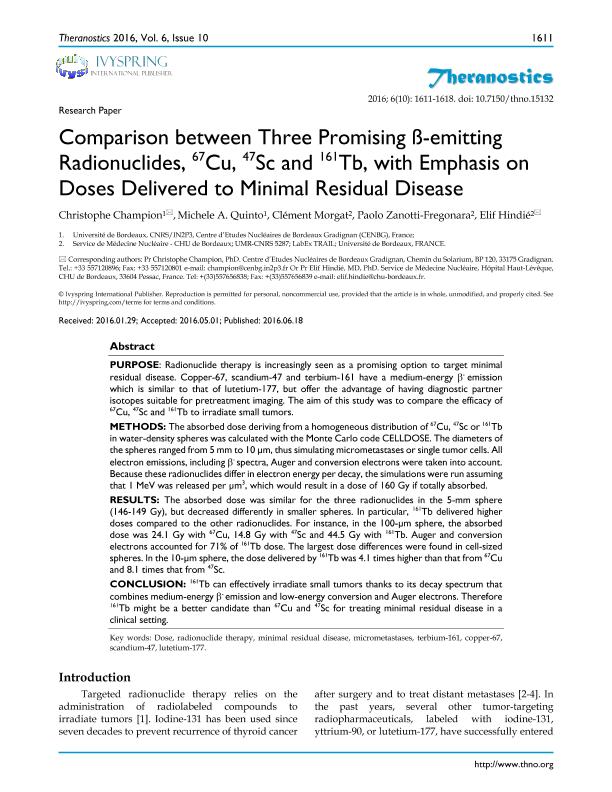Artículo
Comparison between three promising β-emitting radionuclides, 67Cu, 47Sc and 161Tb, with emphasis on doses delivered to minimal residual disease
Champion, Christophe; Quinto, Michele Arcangelo ; Morgat, Clément; Zanotti Fregonara, Paolo; Hindié, Elif
; Morgat, Clément; Zanotti Fregonara, Paolo; Hindié, Elif
 ; Morgat, Clément; Zanotti Fregonara, Paolo; Hindié, Elif
; Morgat, Clément; Zanotti Fregonara, Paolo; Hindié, Elif
Fecha de publicación:
06/2016
Editorial:
Ivyspring International Publisher
Revista:
Theranostics
ISSN:
1838-7640
Idioma:
Inglés
Tipo de recurso:
Artículo publicado
Clasificación temática:
Resumen
PURPOSE: Radionuclide therapy is increasingly seen as a promising option to target minimal residual disease. Copper-67, scandium-47 and terbium-161 have a medium-energy β- emission which is similar to that of lutetium-177, but offer the advantage of having diagnostic partner isotopes suitable for pretreatment imaging. The aim of this study was to compare the efficacy of 67Cu, 47Sc and 161Tb to irradiate small tumors. METHODS: The absorbed dose deriving from a homogeneous distribution of 67Cu, 47Sc or 161Tb in water-density spheres was calculated with the Monte Carlo code CELLDOSE. The diameters of the spheres ranged from 5 mm to 10 μm, thus simulating micrometastases or single tumor cells. All electron emissions, including β- spectra, Auger and conversion electrons were taken into account. Because these radionuclides differ in electron energy per decay, the simulations were run assuming that 1 MeV was released per μm3, which would result in a dose of 160 Gy if totally absorbed. RESULTS: The absorbed dose was similar for the three radionuclides in the 5-mm sphere (146-149 Gy), but decreased differently in smaller spheres. In particular, 161Tb delivered higher doses compared to the other radionuclides. For instance, in the 100-μm sphere, the absorbed dose was 24.1 Gy with 67Cu, 14.8 Gy with 47Sc and 44.5 Gy with 161Tb. Auger and conversion electrons accounted for 71% of 161Tb dose. The largest dose differences were found in cell-sized spheres. In the 10-μm sphere, the dose delivered by 161Tb was 4.1 times higher than that from 67Cu and 8.1 times that from 47Sc. CONCLUSION: 161Tb can effectively irradiate small tumors thanks to its decay spectrum that combines medium-energy β- emission and low-energy conversion and Auger electrons. Therefore 161Tb might be a better candidate than 67Cu and 47Sc for treating minimal residual disease in a clinical setting.
Archivos asociados
Licencia
Identificadores
Colecciones
Articulos(IFIR)
Articulos de INST.DE FISICA DE ROSARIO (I)
Articulos de INST.DE FISICA DE ROSARIO (I)
Citación
Champion, Christophe; Quinto, Michele Arcangelo; Morgat, Clément; Zanotti Fregonara, Paolo; Hindié, Elif; Comparison between three promising β-emitting radionuclides, 67Cu, 47Sc and 161Tb, with emphasis on doses delivered to minimal residual disease; Ivyspring International Publisher; Theranostics; 6; 10; 6-2016; 1611-1618
Compartir
Altmétricas



